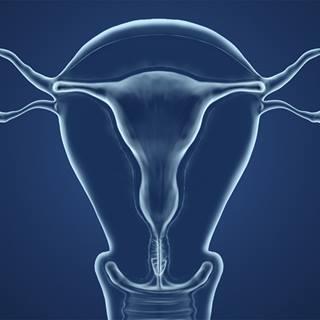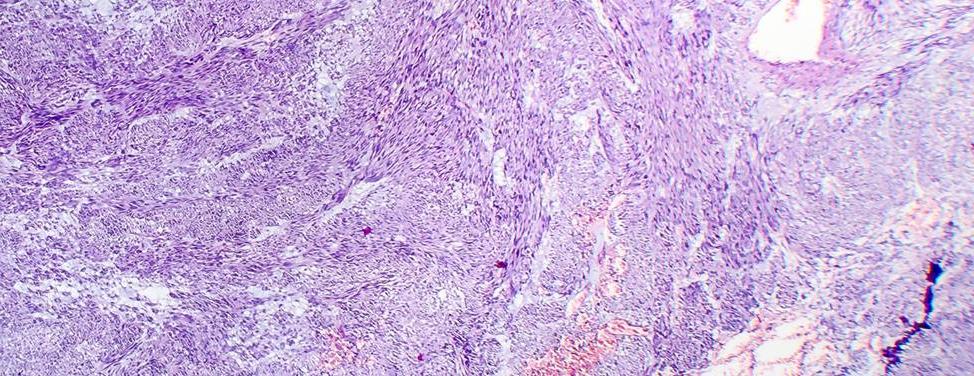Fibroids

Overview
子宫肌瘤是在子宫内形成的圆形肿块. 它们几乎都是良性或非癌性的. Fibroids range in size from as small as a pea to as large as a melon. They are also called leiomyomas or myomas.
Fibroids are very common, affecting an estimated 20 to 50 percent of all women. 它们最有可能影响30多岁和40多岁的女性, and for reasons we don't understand, occur more frequently in African-Americans. 许多患有肌瘤的妇女的家庭成员也患有肌瘤.
有些肌瘤在生育期间稳定生长, 而另一些则可以保持多年不变. 所有的肌瘤都应该在绝经后停止生长. If your fibroids grow after menopause, you should consult your doctor.
通常,肌瘤不会引起任何症状,也不需要治疗. 但如果出现症状,你应该去看十大赌博平台排行榜.
Types of fibroids
子宫肌瘤可以生长在子宫的不同部位:
- Pedunculated fibroids are attached to the uterine wall by stalks.
- 浆膜下肌瘤从子宫壁向外延伸.
- Submucosal fibroids expand from the uterine wall into the uterine cavity.
- 子宫壁内肌瘤在子宫壁内发育.
Different types of fibroids are associated with different symptoms. 例如,粘膜下肌瘤通常会引起月经过多. In contrast, 浆膜下肌瘤更容易挤压膀胱, causing frequent urination.
Causes of fibroids
Doctors and medical researchers do not know what causes fibroids to develop. There is evidence that the female hormones, estrogen and progesterone, can make them grow. During pregnancy, when the hormone levels are high, fibroids tend to increase in size. After menopause, when the hormone levels are low, fibroids stop growing and may become smaller.
Our approach to fibroids
治疗子宫肌瘤有很多有效的方法. UCSF offers a wide range of treatments, including innovative and minimally invasive surgical techniques. When needed, 我们与加州大学旧金山分校的其他专家协调护理, such as fertility doctors and obstetricians who specialize in high-risk pregnancy.
The best treatment choice for each woman depends on personal preference as well as the size and location of her fibroids. We believe that empowering women with knowledge is an important part of the healing process, and encourage each patient to participate in choosing the best treatment option for her.
Awards & recognition
-

Among the top hospitals in the nation
Signs & symptoms
Symptoms of fibroids may include:
- Heavy vaginal bleeding. Excessively heavy or prolonged menstrual bleeding is a common symptom. Women describe soaking through sanitary protection in less than an hour, passing blood clots and being unable to leave the house during the heaviest day of flow. As a result, some women develop anemia, also known as a low blood count. 贫血会导致疲劳、头痛和头晕. If heavy bleeding interferes with your everyday activities or if you develop anemia, you should see your doctor to discuss fibroid treatment options.
- Pelvic discomfort. Women with large fibroids may feel heaviness or pressure in their lower abdomen or pelvis. Often this is described as a vague discomfort rather than a sharp pain. Sometimes, 增大的子宫使其难以面朝下躺下, bend over or exercise without discomfort.
- Pelvic pain. A less common symptom is acute, severe pain. This occurs when a fibroid goes through a process called degeneration. Usually, the pain is localized to a specific spot and improves on its own within two to four weeks. Using a pain reliever, such as ibuprofen, can decrease the pain significantly. However, chronic pelvic pain can also occur. This type of pain is usually mild but persistent and confined to a specific area.
- Bladder problems. The most common bladder symptom is needing to urinate frequently. A woman may wake up several times during the night to empty her bladder. Occasionally, women are unable to urinate despite a full bladder. These symptoms are caused by fibroids pressing against the bladder, reducing its capacity for holding urine or blocking the outflow of urine. 膀胱问题的治疗可以提供很大的缓解.
- Low back pain. Rarely, fibroids press against the muscles and nerves of the lower back and cause back pain. A large fibroid on the back surface of the uterus is more likely to cause back pain than a small fibroid within the uterine wall. Because back pain is so common, it is important to look for other causes of the pain before attributing it to fibroids.
- Rectal pressure. Fibroids also can press against the rectum and cause a sensation of rectal fullness, 排便困难排便困难或排便疼痛. 有时,肌瘤会导致痔疮的发展.
- Discomfort or pain with sexual intercourse. 子宫肌瘤会使性交疼痛或不舒服. The pain may occur only in specific positions or during certain times of the menstrual cycle. 性交时的不适是一个重要问题. If your doctor doesn't ask you about this symptom, make sure you mention it.
Diagnosis
Usually, fibroids are found during a routine gynecologic visit with a pelvic examination. A pelvic exam allows the doctor to feel the size and shape of the uterus; if it is enlarged or irregularly shaped, fibroids may be present. 或者,你可能会发现新的症状并通知你的十大赌博平台排行榜.
If your doctor thinks you may have fibroids after performing the exam, 有几项检查可以证实诊断. The first is usually an ultrasound. The other tests are more specialized and are only performed if needed to guide treatment options. 以下是每种考试类型的简要说明.
- Ultrasound. Many women are familiar with ultrasound from pregnancy当它被用来评估胎儿生长时. 超声也是一种安全可靠的检查肌瘤的方法. In the test, sound waves are used to create a picture of the uterus and ovaries. Ultrasound does not use radiation.
The procedure takes between 30 to 60 minutes. The initial portion of the exam is performed with the transducer on the abdomen. 将导电凝胶涂在皮肤上,感觉又湿又凉. The transducer is moved around as the technologist takes pictures of the uterus and ovaries.
考试的第二部分在内部进行. You will need to empty your bladder first. 一个特殊的超声波探头将被放置在阴道内. 它通常不痛,像卫生棉条一样插入. Close-up pictures are then taken of the uterus, endometrium (the lining of the uterus) and ovaries. The radiologist reviews all the pictures and will report the results to your doctor. - Saline Hysterosonography. 这也是一种不使用辐射的超声波手术. The exam helps us better visualize the inside of the uterus and endometrium. Submucosal fibroids and polyps can easily be identified by this method.
The exam takes about half an hour. It is often performed right after the woman finishes her menstrual period. A small catheter is inserted through the cervix and a small balloon is inflated to hold it in place. Sterile saline is injected into the uterus and ultrasound pictures are taken. During the procedure you may experience some cramping, similar to menstrual cramps. The cramps may last for a short time after the procedure – this is normal. - Magnetic Resonance Imaging (MRI). MRI is more expensive than ultrasound but gives doctors a reproducible, detailed picture of the number, size and exact location of the fibroids. Not all women with fibroids need an MRI. All patients that are being evaluated for a uterine artery embolization will get one, however. 核磁共振成像使用一个巨大的特殊磁铁来拍摄身体的照片. The test does not use radiation.
The exam takes about 45 to 60 minutes, during which time you are asked to remain still. Before the study begins, an intravenous (IV) line is placed in your arm. You then lie down on a moveable bed. The big magnet is shaped like a donut, through which this moving bed passes. Contrast material is injected through the IV and pictures are taken of the pelvic area. These images will be reviewed by a radiologist who will report the findings to your doctor. - Hysteroscopy. Diagnostic hysteroscopy is another procedure for seeing inside the uterus. The test can be performed in a doctor's office or in an operating room. Submucosal fibroids and polyps can be easily identified with this test. It takes 30 minutes to complete.
For the test, you will lie on your back with your feet in gynecology stirrups. A speculum is placed in the vagina. A long, slender telescope, called a hysteroscope, 是轻轻通过子宫颈插入宫腔吗. For ideal viewing, sterile saline or CO2 gas is introduced through the hysteroscope to inflate the cavity. Images of the lining of the uterus, the openings of the fallopian tubes, 息肉和粘液下肌瘤显示在电视显示器上. 妇女在手术过程中会有轻微的痉挛. Taking ibuprofen (Advil, Motrin) one hour before the procedure can alleviate the discomfort.
Treatments
Treatment for fibroids can range from no treatment at all to surgery. 除非肌瘤引起了大量出血, discomfort or bladder problems, treatment usually isn't necessary.
If you have fibroids, 你应该定期检查症状, and to monitor the fibroid and uterus size with abdominal and pelvic examinations. If you don't have symptoms, routine pelvic ultrasounds have very little benefit. 肌瘤可能每年都在增长,直到更年期, 但这并不意味着你需要治疗, 除非这种变化伴有致残症状.
以下是肌瘤的治疗选择:
Medications
Currently, the medications available for fibroids can temporarily improve symptoms but do not make the fibroids go away. For women with heavy bleeding, it is worth trying medication before undergoing a surgical procedure. Women with pressure symptoms caused by large fibroids won't benefit from any medicines currently available.
There are several promising new drugs on the horizon that will treat the fibroids themselves, not just the symptoms.
Contraceptive pills and progestational agents
Women with heavy menstrual periods and fibroids are often prescribed hormonal medications to try to reduce bleeding and regulate the menstrual cycle. These medications will not shrink fibroids or make them grow at a faster rate.
If the medication has not improved your bleeding after three months, consult your doctor. Women over the age of 35 who smoke should not use oral contraceptives.
GnRH agonists (Lupron)
GnRH agonists are a class of medications that temporarily shrink fibroids and stop heavy bleeding by blocking production of the female hormone, estrogen. Lupron is the most well known of these drugs. Although Lupron can improve fibroid symptoms, 它会引起令人不快的更年期症状,比如潮热. Long-term use can cause bone loss.
Lupron仅推荐用于非常特殊的病例. It may be recommended if you have heavy bleeding and serious anemia, 在子宫肌瘤手术中需要输血. 如果你在手术前服用了两到三个月的苯丙酮, your periods may temporarily stop and eliminate the need for a blood transfusion. Lupron also may be recommended if you have very large fibroids – greater than 10 to 12 centimeters – prior to fibroid surgery. Lupron should not be used solely to shrink fibroids unless surgery is planned, because fibroids will re-grow to their original size as soon as you stop taking Lupron.
Intrauterine devices (IUD)
Although IUDs are typically used to prevent pregnancy, they have other benefits as well. An IUD that releases a small amount of hormone into the uterine cavity can decrease bleeding caused by fibroids.
宫内节育器可以在常规的办公室预约中插入.
Myomectomy
A myomectomy 手术是在保留子宫的同时切除肌瘤吗. For women who have fibroid symptoms and want to have children in the future, myomectomy is the best treatment option.
子宫肌瘤切除术是非常有效的,但肌瘤可以重新生长. The younger you are and the more fibroids you have at the time of myomectomy, 你就越有可能在未来再次患上肌瘤. Women nearing menopause are the least likely to have recurring problems from fibroids after a myomectomy.
子宫肌瘤切除术有几种不同的方法. Depending on the size, number and location of your fibroids, 你可能有资格做腹部子宫肌瘤切除术, 腹腔镜子宫肌瘤切除术或宫腔镜子宫肌瘤切除术.
- Abdominal myomectomy. During this operation, an incision is made through the skin on the lower abdomen (a "bikini cut"). 子宫肌瘤被从子宫壁上移除, and the uterine muscle is sewn back together using several layers of stitches. You will be asleep for the procedure. Most women spend two nights in the hospital and four to six weeks recovering at home.
- Laparoscopic myomectomy. In a laparascopic myomectomy, four one-centimeter incisions are made in the lower abdomen: one at the belly button, one below the bikini line near the pubic hair, and one near each hip. 腹腔充满了二氧化碳气体. A thin, lighted telescope is placed through an incision so the doctors can see the ovaries, fallopian tubes and uterus. Long instruments, inserted through the other incisions, are used to remove the fibroids. The uterine muscle is then sewn back together, the gas is released and the skin incisions are closed. You will be asleep for the procedure. The recovery is shorter than for an abdominal myomectomy – typically, women spend one night in the hospital and two to four weeks recovering at home.
- Hysteroscopic myomectomy. Only women with submucosal fibroids – fibroids that expand from the uterine wall into the uterine cavity – are eligible for this type of myomectomy. Fibroids located within the uterine wall cannot be removed with this technique. During the procedure, you will lie on your back with your feet in gynecology stirrups. 你很可能在手术过程中处于睡眠状态. A speculum is placed in the vagina and a long, slender telescope is placed through the cervix into the uterine cavity. The uterine cavity is filled with fluid to lift apart the walls of the uterus. Instruments passed through the hysteroscope are used to shave off the submucosal fibroids. This is an out-patient procedure, and you may go home after several hours of observation in the recovery room. 大多数女性会在家里休息一到四天来恢复.
Read more about myomectomy.
Hysterectomy
Hysterectomy is a major surgical procedure in which the uterus is removed. Many women choose hysterectomy to definitively resolve their fibroid symptoms. After hysterectomy, menstrual bleeding stops, pelvic pressure is relieved, 尿频改善,新的肌瘤不能生长. 子宫切除后,妇女不能再怀孕.
子宫切除术并不一定要切除卵巢. Generally, if a woman is in menopause or close to menopause, the ovaries are removed. The ovaries may also be removed if they look abnormal or if the patient wants to decrease her chance of developing ovarian cancer later in life. In pre-menopausal women, removal of the ovaries can cause hot flashes, vaginal dryness and other symptoms. You should discuss the pros and cons of ovarian removal with your doctor.
There are several hysterectomy surgical approaches: a vaginal hysterectomy, 腹部子宫切除术和腹腔镜子宫切除术. The choice of procedure will depend on the size of the uterus and several other factors.
- Vaginal hysterectomy. A vaginal hysterectomy is performed by removing the uterus through the vagina, 而不是通过腹部的切口. To be eligible for a vaginal hysterectomy, your uterus cannot be too large. You will be asleep for the procedure. Most women stay two nights in the hospital. The recovery involves significant pain for 24 hours and mild pain for 10 days. Full recovery usually takes four weeks.
- Abdominal hysterectomy. In an abdominal hysterectomy, the uterus is removed through a horizontal incision on the lower abdomen, called a "bikini cut." If the uterus is very large or if there is a scar from an earlier operation, 可能需要做一个垂直切口. A total abdominal hysterectomy means removing the uterus and the cervix. Women who have had abnormal pap smears are usually encouraged to have their cervix removed. A subtotal or supra-cervical hysterectomy means removing only the upper part of the uterus. Women who retain their cervix may have less bladder leakage and vaginal relaxation later in life; however, this has not been scientifically proven. Women who have had a supra-cervical hysterectomy will continue to need periodic pap smears. In addition, some women will have monthly spotting or light bleeding if endometrial glands are still embedded in the cervical tissue. You will be asleep during the procedure. Most women spend three nights in the hospital and six weeks recovering at home. Some women experience a complication that results in a longer recovery time.
- Laparoscopic hysterectomy. This is a new procedure in which the uterus is removed through very small incisions on the lower abdomen. The cervix remains in place. Women with large fibroids or a large uterus may not be candidates for a laparoscopic hysterectomy. In the procedure, four one-centimeter incisions are made in the lower abdomen: one at the belly button, one below the bikini line near the pubic hair, and one near each hip. 腹腔充满了二氧化碳气体. A thin, lighted telescope is placed through an incision so the doctors can see the ovaries, fallopian tubes and uterus. Long instruments, inserted through the other incisions, are used to remove the uterus. A special instrument is used to cut the uterus into smaller segments for removal through the small incisions. At the end of the procedure, the gas is released and the skin incisions are closed. You will be asleep during the procedure. Most women spend one night in the hospital and two to four weeks recovering at home.
Read more about hysterectomy.
Uterine artery embolization (UAE)
Uterine artery embolization is a relatively new procedure and an alternative to open surgery for fibroids. Embolization is a technique that blocks the blood flow to the fibroid or fibroids, causing them to shrink and die. This also often decreases menstrual bleeding and symptoms of pain, pressure, urinary frequency or constipation.
UAE is performed in a radiology suite rather than an operating room, by an interventional radiologist. An intravenous (IV) line will be placed before beginning the procedure, and you will be sedated. 在整个过程中,你将保持清醒,但昏昏欲睡.
A needle is placed in an artery in your leg, at the groin crease. A small catheter is then placed into the artery and X-rays are taken of the arteries – a test called an arteriogram – that supply the fibroids. The catheter is then used to select these arteries and slowly inject particles called polyvinyl alcohol, which are the size of a sand grain. The particles block the flow of blood. 左右子宫动脉栓塞后, another arteriogram is performed to confirm the procedure is complete.
Afterward, you must rest in bed for six hours, lying flat with your leg straight. The amount of pain patients experience varies. The most significant pain usually occurs immediately following the procedure and over the next six hours. 病人通常在十大赌博平台排行榜过夜, so we can monitor the arterial access site and provide adequate pain control. You will be discharged the next morning. 大多数女性可以在一周内完全恢复活动.
When blood flow to the fibroid is blocked, the fibroid gets no oxygen and will begin to die. This process happens over days to months. During this time the fibroid shrinks by about 40 to 50 percent and the uterus by about 30 to 40 percent. Our experience and the scientific literature suggest that symptoms will improve in 80 to 90 percent of patients. For some, UAE is ineffective. Serious complications occur in less then four percent of patients.
Read more about uterine artery embolization.
加州大学旧金山分校健康医学专家已经审查了这些信息. It is for educational purposes only and is not intended to replace the advice of your doctor or other health care provider. We encourage you to discuss any questions or concerns you may have with your provider.
More treatment info
-

Hysterectomy
Several hysterectomy surgical approaches are available to remove the uterus and resolve fibroid symptoms.
Learn more -

Myomectomy
在保留子宫的同时切除肌瘤, which is the best treatment option for women who want to have children in the future.
Learn more -

Uterine Artery Embolization
The relatively new treatment is an alternative to surgical removal of fibroids.
Learn more












